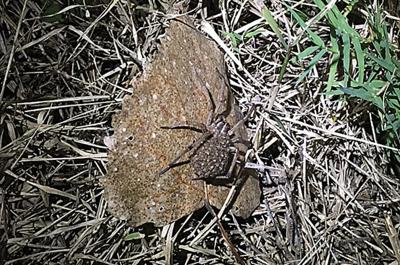While walking on a trail or through the woods, I react much like everyone else when I feel a strand of spider web across my face or see an arachnid swinging from an invisible string attached to my arm. These encounters are more than a little unsettling.
Spiders get way more blame for disrupting the universe than they deserve. Their positive attributes far outdistance their negative reputation. Many Halloween decorations feature artificial webs and giant black spiders, but the reality is the tiny creatures shouldn’t be considered very scary.
Missouri is home to more than 300 kinds of spiders. The Texas brown tarantula is the largest in the state, with an average body length of up to two inches. They are found in dry glade areas south of the Missouri River.
Many of the spiders we may come across are barely visible. The smallest are about the size of a pinhead, and even if they are not apparent to most observers, they are all over the place. Arachnologists estimate that every acre of woodland has about 30,000 spiders. Each acre of grassland in Missouri may be home to about 2.5 million spiders.
The state Department of Conservation website offers facts about the importance of arachnids in insect control. Farmers rely on the tiny predators to eliminate bugs that can devastate crops.
“Spiders eat more insects than birds and bats combined,” the department states. “Since each spider in a field may consume at least one insect per day, their cumulative effect on insect populations is significant.”
Some spiders are considered cannibals, and while spiders do eat spiders, they also are food themselves for birds, bats, small mammals, mud dauber wasps, and others.
The real concern among humans is the fear of being bitten by a spider, but that should scale down to a pinhead, too. Spider bites are rare, and severe reactions even rarer. Very few spiders can pierce human skin, and even though all spiders can inject venom, only a couple are capable of delivering more than a mosquito-bite reaction.
“Of the two potentially harmful spiders found in Missouri, you are more likely to encounter the brown recluse than the black widow. Both can inflict bites that can cause severe pain and infection,” according to the conservation department website. “Deaths due to black widow bites are extremely rare, and no deaths have been proven to be caused by brown recluse bites. Deaths attributed to spiders usually occur in individuals who have an extreme allergic reaction or immune deficiency to the spider’s venom.”
A local billboard for a pest control company makes me wince every time I see it, and not because it features a 10-foot tarantula. It’s the slogan below it that suggests you “get them before they get you.”
Scare tactics are effective marketing tools, but in reality spiders are not “getting” people. One last note from the website adds this counter-argument to the billboard: “Professional pest-control agents and sprays can be used, but these are often expensive and generally unsuccessful. The spiders are tenacious and not highly susceptible to insecticides.”
I have taken the opposite approach. Spiders are fascinating and exciting to find or follow. Wearing a headlight flashlight at night, you can see the reflection of wolf spider eyes. You also can walk right up to find them in a variety of sizes. Watching orb weavers create their silken works of art or capture and kill a wayward bug are awesome examples of nature at work.
I may swing my arms wildly when I walk through a surprise web, but when I find one before it finds me, I’m more likely to stop for a picture of the arachnid and leave its humble home undisturbed.
John Winkelman has been writing about outdoors news and issues in Jefferson County for more than 30 years and is the Associate Editor for Outdoor Guide Magazine. If you have story ideas for the Leader outdoor news page, e-mail ogmjohnw@aol.com, and you can find more outdoor news and updates at johnjwink.com.




